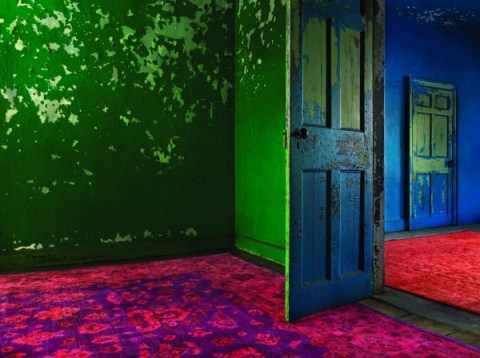
Image and code from wired.com
Ferdinand Saussure provided a framework and vocabulary that can be applied in composition classrooms to understand the “arbitrary” nature of representational forms including sound and image. He famously gave us the vocabulary of semiotics including the “signifier” and “signified” within a framework that leaves meaning as a function of context. By having students explore image and sound as both signified and signifier, this lesson plan demonstrates for students the complexity of representation and meaning-making when accounting for the multimodality of online writing environments.
Recorded sound and photographic image are too often understood by students as objective, as truly representing the physical world in ways that are beyond interpretation. As writing environments increasingly encourage the utilization of these modalities as elements of persuasive texts, it becomes necessary for instructors to help students understand the ways that they are instead language with great variability in how they are assigned and interpreted.
Writing classrooms also sometimes address context in ways that obscure the role of consciousness in meaning making. This lesson plan allows students to juxtapose their own multimodal attributions and interpretations with those of their classmates as they investigate context as a discursive component that is not static and cannot be wholly bounded, particularly when accounting for the ways they are mediated through subjectivities.
Learning Objectives
This assignment provides students greater facility with selecting and interpreting images and sound in multimodal environments. As they attribute and interpret sound and image, and as they compare their conclusions and products with those of their classmates, students will demonstrate and better understand the utter messiness of language in all its forms, including sound and image. Particularly, this assignment hopes to help students accomplish the following:
- Observe the complexity of context in meaning making
- Abandon notions of image and sound as objective
- Gain greater facility persuading with both sound and image
- Obtain basic skills in audio recording and editing
Assignment Length
This assignment will take approximately two ninety-minute class periods.
Required Materials
This lesson plan requires computers, audio recording devices, computer access, Audacity or Garageband, and internet access.
Skills Necessary
Instructor and students will need basic skills with audio recording and audio editing. This lesson includes video tutorials for both.
Access and Adaptability
The assignment’s learning objective concerning the complexity of context could still be reached by having students write a narrative context (as opposed to constructing a sonic one) of the image they encounter. In this alternative, in the second phase of the assignment, instead of listening to each others contexts, they would read them and assign an image. In another alteration students could respond with sonic contexts to a poem or another written text that could be read aloud.
If an instructor stuck with the original design of the lesson plan, but did not have access to digital field recorders, any audio recording app on the students’ smartphones could suffice. If there were not enough smartphones for each student, then pairing the students or putting them in groups is a good workaround. Additionally, Audacity is audio editing software that can be downloaded and used by students for free.
Assignment Description
The lesson plan unfolds over two class periods:
Day one:
Students gain basic familiarity with Saussure’s terminology, and they learn the audio recording and editing skills needed to complete the assignment detailed below. Students are asked to consider a set of still images as both signifieds and signifiers. The portion they will begin in the classroom and complete at home asks them to select an image and create a sonic context that they think helps communicate the meaning of their chosen image.
Day two:
Students are given the opportunity to see how several of their classmates interpreted images and assigned sound differently, and, similarly, they will observe their classmates interpreting and assigning their own contexts differently. That is, students will see just how imperfect meaning making is, even when dealing with sound and image. Students will conclude by reflecting in writing on what they have learned about context.
Instructor Preparation
- Become familiar with Saussure’s terminology and how it applies to context and meaning making.
- View the instructional videos several times and be comfortable helping students with both the Zoom H5 and audio mixing in Audacity.
- Become familiar with freesound.org and its utility for sonic context creation.
Student Preparation
- Read provided excerpts of Saussure’s Course in General Linguistics.
- Watch both instructional videos before day one.
- Create a freesound.org account before day one.
In-Class or Assignment Instructions
Day one: The instructor uses these excerpts from the Course on General Linguistics to explicate the relationship between image, concept, and sound. The instructor then provides students three images found here, here, and here.



Students are instructed to understand each as a “signified” in Saussure’s terminology and asked to answer in a short paragraph the question: “What is happening in this image?” for each of these images.
Students then choose one of the three images and are told they will provide a soundscape for the scene represented in the image. Each is provided a Zoom H5 field recorder and follows along as the instructor plays the relevant instructional video below. At the end of the video, each Zoom H5 should be ready to record. Students are then instructed to imagine and brainstorm in writing some contexts that might accompany their chosen image. The instructor then introduces students to freesound.org and gives them time to register an account. Students familiarize with Audacity by watching the relevant instructional video. They should open the program and follow along. Now in possession of all of the tools they will need to complete the assignment, students are given the rest of the time to begin their sonic context. By both capturing sound with the Zoom H5 and inserting sounds from freesound.org, they will construct the sounds they think best contextualize their image. Their file should be between thirty seconds and one minute long, exported as an mp3, and uploaded to a course discussion board between the end of this class period and the beginning of the next.
Day two: As students have at this point spent some time with their image, have them again reflect on their own image, answering the question “What is happening in this image?” It is likely that their thoughts have changed. Then have them pair up, but instruct them not to tell each other what image they chose. Then have them listen to each others sonic contexts. Have students attempt to match the sonic context they are listening to to one of the three images given on the first day. Concerning the image they choose, have them answer the question: “What is happening in this image?” Then have students disclose to each other which image their sonic context originated from. Have students answer the question again concerning this new image. As time allows, have students continue swapping partners and answering the same question. Finish by having students reflect in writing on both how they interpreted and how they were interpreted.
This video will give students basic familiarity with the Zoom H5.
This video will give students basic familiarity with sound mixing in Audacity.
Assessment Suggestions
Consider simply giving a completion grade to students who take the assignment seriously and finish all components. This assignment could also be graded on its own or as one portion of a larger assignment in which students create an audio product or another project heavily dependent on context.
For portfolio-based and Learning Record assessment, instructors may want to give precedence to the reflection at the end of the assignment. Instructors may also want to account for the ways that students include and reflect on the lessons emphasized in this assignment throughout the course.
For traditional assessment, instructors may want to grade students on how robustly they engage the audio creation portion of the assignment, including their willingness to use all of the technology introduced to them, for example. Consider also assessing the students’ ability to understand and apply the Saussurean concepts.





